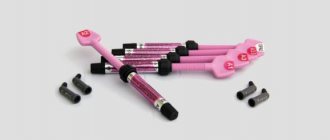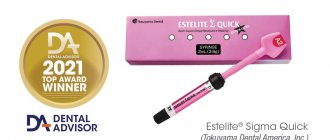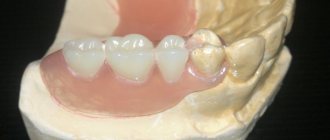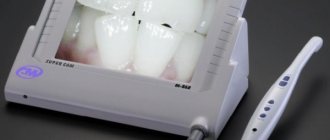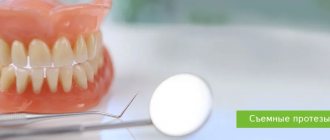8398
Those years when a visit to the dentist and the procedure for filling an affected tooth were the subject of physical and moral torment are far in the past.
Now, thanks to innovative scientific developments, high-quality and safe materials and modern equipment, monitoring the health of the oral cavity and promptly eliminating problems that arise has become comfortable and harmless.
This article will discuss the currently best filling material Estelite.
General overview
Estelite Sigma Quick is a modern composite mass, specially developed by Japanese specialists in the field of dental practice for filling teeth.
The drug is a universal set of elements characterized by radiopaque characteristics and excellent light-curing properties.
Combined with a high aesthetic factor and fast polymerization processes, the material has proven itself in clinics around the world, being one of the best products among its product range.
Composition and properties
A high-quality result and a high strength index are ensured due to excellent mechanical and physical characteristics due to the presence of all the constituent elements of the composite.
More than 80% of it consists of silicon-zirconium mass, which ensures minimal shrinkage of the material subsequently .
Choosing the right shade is quite easy - the product line includes about two dozen color options. The composition is perfectly polished, and the high-quality result lasts for a long period of time.
The mass is resistant to abrasion and has the highest wear resistance class.
In what clinical cases is the method of retrograde root canal filling justified?
Come here to get to know Filtek filling material better.
At this address https://www.vash-dentist.ru/lechenie/zubyi/plombyi/stekloionomernogo-tsementa.html we will discuss the pros and cons of glass ionomer cement for filling teeth.
What is the best filling material?
Many dental clinics offer several different filling materials. The price lists (also on the websites) also include various commercial names of fillings: Filtek, Spectrum, Esthetix, Charisma, Venus, Gradia, Estelite, Herculite, Point, Tetrick, Admira, Brilliant, Enamel Plus and others. Patients are asked to make a choice, but this requires dentist-level knowledge, which most people certainly do not have.
Popular articles on the Internet with questions such as “which filling is better?”, “Which filling material is better?”, “Which filling is better to use?” Etc. – not very helpful in explaining the situation. Most articles (often written by anonymous authors or copywriters) discuss only classes of filling materials: cements, amalgams, glass ionomers, chemical- and light-curing composites. After detailing materials that fell out of use several decades ago (apparently to increase the length of the text), it is concluded that light-curing composites are best, and if one has the financial resources, they should be used for restoration. No specific brands of gel composites are mentioned, or they are all considered to be about equally good. Or they will start advertising “the latest generation of nanocomposites.”
What fillings do not need to be placed?
The first and most important thing that every patient must understand is that light-curing fillings (photopolymers, helioprost) are the only reasonable choice in the 21st century. Even for cashless people. The remaining materials are not 10 or 20 percent, but many times worse. Discussing the benefits or price-performance ratio of cement putties in this day and age is as foolish as looking for advantages, for example, It has been a long time since no one makes or buys cassette recorders and VCRs, but for some reason some people can afford 19th century print.
Plastic gaskets are beyond comprehension. Acrylic oxide and similar anachronisms should have been banned for use a quarter of a century ago, because it not only cannot stop the further spread of caries, but also provoke its progression. Plastic fillings on a tooth are a direct path to pulpitis and periodontitis. You must hate yourself so much that you would allow something like that to be shoved into your mouth. And clinics using such materials must have a license.
Amalgam fillings are known for their longevity, but due to their toxicity (not to the patient, but to the environment and healthcare workers), dentists reject them.
Chemical composites are on average bad - if someone lives poorly, they can certainly get them (better than nothing). But for most people who don't have a pressing daily need, this would be an unwise choice. This can be a little troublesome, and such a filling will last for many years, but more often the opposite is true. After 3-5 years (or less), a cavity will form under the "chemical" filling and the problem may eventually reach the point of pulpitis, or the size of the damage will be so large that an inlay or overlay will be needed instead. second filling. As a result, the cost of re-processing increases by an order of magnitude due to thousands of rubles saved for the first time (an approximate difference with the cost of a light-curing composite).
Light-curing fillings are not uniform
Glass ionomer cements with a light curing mechanism are also available. For example Fuji 2 (Fuji II LC). Compomers (a hybrid material between composites and glass ionomers) are also light-curing. Their most famous representative is Dyract XP. These materials are more reliable than some heliocomposites, but are still inferior to their best analogues. Due to misconceptions about the toxicity of composites, some clinicians recommend using these materials for restorations in children. In pediatric dentistry, Fuji and Direct are acceptable options, but composites are preferred.
Dental composites are divided into universal materials (suitable for any cavity), aesthetic composites for anterior teeth (perfectly reproduce all the nuances of the color of a natural tooth) and opaque composites for posterior teeth (characterized by low shrinkage and abrasion, but also low aesthetics). There is another class of composites - floating. In the past, they were recommended for filling wedge-shaped defects due to their high flexibility, but current evidence shows that flowable composites also perform better in this non-carious lesion. 1 As a result, modern composites currently have only ancillary value: they are used in conjunction with other classes of materials but do not constitute the majority of prosthetic restorations.
Universal gel composites are the most widely used filling material in the world. The commercial names of the fillings offered to the patient to choose from mainly refer to these materials. There is also a big difference in their quality. The percentage of inorganic filler, its chemical composition and the shape of the granules determine the mechanical properties of the filler: polymerization shrinkage, mechanical strength, hardness and durability, polishability and surface smoothness. Some of these parameters are antagonistic to each other. For example, for good polishability, granules of unlimited filler (oxides of silicon, zirconium, aluminum, etc.) should be as small as possible, and, on the contrary, as large as possible to increase strength. Therefore, materials advertised as “nanocomposites” make specialists smile – the prefix “nano” attracts illiterate dentists and patients who blindly associate it with advanced technologies. However, it may turn out to be good material. For example, Filtek Ultimate.
Principle of operation
During the use of the material, dentin fragments are filled with the drug simultaneously, which allows achieving the same depth of internal penetration of adhesives and demineralization of the composition. The monomer forms a single structure through its 100% filling .
Regardless of the quality of the working area - dry, wet, or having undergone a preliminary preparation procedure, the adhesion force will be equally reliable.
The doctor is obliged to calculate the filling boundary as accurately as possible - a colored pigment will help him with this, which will subsequently disappear from the surface of the tooth on its own.
An important characteristic of the drug , which distinguishes it from analogue options, is a decrease in enamel sensitivity and a decrease in permeability.
Main advantages of Estelite:
- versatility of use;
- simplicity and ease of use.
Indications and contraindications
Due to the almost complete versatility of the product, the range of indications for its use is quite wide.
The drug can be used in most clinical situations, in particular:
- for direct restoration of the frontal zone of the jaw row , for example, for small anterior cavities
- when eliminating minor surface defects caused by mechanical damage - cracks, chips;
- as a base layer when performing direct restoration;
- for the treatment of organs by indirect restoration;
- to eliminate external defects of other previously applied composite materials;
- restoration of artificial row fragments;
- elimination of gaps and diastemas of varying degrees of severity;
- in the process of forming composite veneers - when applying the thinnest multi-layer overlays;
- therapy of caries manifestations of all types.
Since the component contains methacrylic monomers, the main contraindication to the use of the mass is individual intolerance to this element, as well as a tendency to develop allergies to methacrylics and similar compounds.
Contraindications
For some people, the use of Estelite material may cause allergic reactions to one or another component in the composition (most often to methacrylic monometers). In this case, you should stop using it and look for an analogue. There are no other contraindications to the use of nanocomposite, which is why it is considered universal, since it is used even for treating the teeth of small children.
After filling, the oral cavity is thoroughly cleaned and rinsed with water to avoid material getting into the mucous membrane or into the esophagus. Composite particles may cause irritation or other health problems.
Rules for tooth preparation
Preparing the organ for the upcoming manipulation is an important process of therapy in general. Like the main stages of restoration, it is carried out strictly in accordance with the protocol and includes the following sequential actions of the doctor:
- cleaning the enamel - the surface of the jaw row is carefully but thoroughly cleaned with a special rubber container with a mass that does not contain fluoride components. After treatment, the working area is washed with water;
- tone selection – carried out using a shade scale. For the most accurate result, the selection time is a few minutes, since wet teeth are darker, and dry teeth, on the contrary, are lighter.
The main principle of selection is color saturation; from the most suitable options, the specialist will choose the most intense.Important! Professional whitening cannot be performed before the procedure. In this case, there is a high risk of tone discrepancy, since some time after bleaching the organs will become darker and the discrepancy will be noticeable;
- insulation – the best option is rubber dam;
- preparation - manipulation is carried out according to the standard procedure, after which the surface is washed with water. When treating the frontal zone, bevels are made along the marginal part of the enamel, and in the lateral zone, the edges are somewhat smoothed. This will improve retention and aesthetic perception;
- pulp protection - if the working cavity and the pulp are located nearby, a gasket is applied, which serves as a barrier protecting the delicate pulp tissue.
It is made from glass ionomer or calcium hydroxide. The use of eugenol and its derivatives as protection is not recommended, since the material impairs the polymerization process of Estelite; - application of adhesive - single-component mixtures with this filling composition are shown. However, they should not be self-curing, since the material will not provide the necessary adhesion effect.
Indications and contraindications for unfilling tooth canals.
In this article we will talk about the composition and properties of the Spectrum filling.
Here https://www.vash-dentist.ru/lechenie/zubyi/plombyi/restavratsii-tsementnyih.html read about the service life of cement fillings.
Advantages
The main advantages of using the Japanese Estelite material are its versatility and aesthetics. The brand’s nanocomposite called “Sigma Quick” is suitable for the restoration and restoration of both chewing teeth and the anterior row.
The filling material “Estelight Sigma Quick” has many advantages:
- used both to restore color and to give the correct shape to the front or lateral dentition;
- high wear resistance (tooth enamel does not wear off or deform during prolonged use);
- a large number of shades, which makes it possible to choose the most suitable one for the dentition;
- has a “chameleon effect” (the filling acquires the shade of the tooth over time, this in turn minimizes the incorrectly selected material);
- simplicity and speed of application;
- the surface of the tooth is shiny and smooth.
This is interesting: How to use chlorhexidine: dilute it correctly
But the Russian market also offers Italian-made material “Estelight Asteria”, which has similar qualities and advantages to the Japanese product. The only difference between these two filling materials is that “Asteria” has a somewhat limited range of colors, and is also applied to the tooth in two layers. The remaining characteristics, high quality, and also the price are almost the same.
Stages of restoration
Unidoses should be used only within the instructions for use of the composition.
An ounce is measured in the dispenser, then the protective cap is removed. The paste is squeezed directly into the working cavity or preliminarily brought to the required consistency on a tablet.
If a syringe is used, the operating principle is as follows:
- remove the cap;
- turn the handle clockwise;
- squeeze the required amount of component onto the tablet;
- knead the paste.
After the material is ready for use, filling and restoration contouring begin . The paste is introduced into the hole in layers, not exceeding the maximum permissible depth in one application. The manufacturer offers a special table for this.
During the filling process, mixing Estelite with other pastes is unacceptable; this is fraught with the formation of voids and poor-quality polymerization.
Each layer must be polymerized separately - the time stated by the manufacturer. The device is located at a distance of about 2 mm from the working area.
The final stage is finishing. The restoration area is cleaned and polished using fine-grained diamond burs.
To make the boundaries between the filling and the tooth look as natural as possible, the doctor performs fractional grinding with a multifaceted carbide bur. No water is used, and the rotation speed of the bur is minimal.
The proximal parts are treated with special thin strips of vinyl or medical metal alloy.
The finished surface is polished with rubber nozzles or special devices designed for this.
The video provides a basic guide to using Estelite filling material.
Estelite instructions
1. Cleaning Thoroughly clean the tooth surface with a rubber cup containing fluoride-free paste, and then rinse with water.
2. Shade selection Before installing the rubber dam, select the appropriate shade using the Estelite Sigma Quick shade guide.
- The shade must be selected within 5 minutes; Dry teeth are lighter than moistened teeth.
- White saturation (color intensity) is the most important factor in choosing a shade.
- If you're debating between two shades, choose the lighter shade (the shade that has the most color intensity).
- When working with whitened teeth, shade selection should be done a few weeks after the whitening procedure. Whitened teeth may darken slightly.
3. Isolation Rubber dam is the best method for isolating a tooth.
4. Preparing the cavity Prepare the cavity and rinse thoroughly with water. Bevel the edges of the enamel when preparing anterior teeth (Class III, IV, V) and smooth the edges of the enamel when preparing posterior teeth (Class I, II). Bevels and smoothing of the enamel edges ensure that the boundary between the cavity edge and the restoration disappears, improving aesthetics and retention. — From the point of view of aesthetics and strength, scalloped bevels (undulant, scalloped bevel) are preferable. — When restoring ceramic or composite restorations, roughen the surface with a diamond bur to improve adhesion; for cleaning purposes, etch the tooth surface with phosphoric acid; rinse thoroughly with water; dry the tooth surface and apply silane according to the manufacturer's instructions.
5. Protection of the pulp If the cavity is located in close proximity to the pulp, a gasket made of glass ionomer material or calcium hydroxide should be applied. EUGENOL BASED MATERIALS SHOULD NOT BE USED for pulp protection as they will inhibit the polymerization of the bond and/or ESTELITE Σ QUICK.
6. Adhesive System Apply light-curing adhesive system according to the manufacturer's instructions. We recommend using TOKUYAMA BOND FORCE, which is a one-part, self-etching, light-curing dental adhesive. — Self-curing adhesive systems should not be used. With Estelite we recommend the use of light-curing adhesive systems, since other types of adhesive systems, such as, for example, self-curing adhesive systems or dual-curing systems, will not provide effective adhesion when using light-curing composite materials. If you do use self-curing or dual-cure adhesive systems, make sure they can be used with light-curing composite materials.
7. Dosing 7-1. Unidose (PLT) Before use, carefully read the Special Instructions for Use of Unidose. — Place the PLT in a suitable dispenser. — Remove the PLT cap. — Apply the paste directly into the cavity or pre-squeeze it onto the mixing plate.
7-2. Syringe Remove the cap of the syringe. Turn the handle clockwise to squeeze out the paste onto the mixing plate. Immediately after this, put the cap on the syringe. - DO NOT apply excessive force to the syringe if it has just been removed from the refrigerator.
8. Filling and contouring of the restoration Bring the material into the cavity layer by layer. The layer of material should not exceed the specified depth (check the table above). - DO NOT mix Estelite Sigma Quick with other types of composite materials or other shades of Estelite Sigma Quick to avoid incomplete polymerization or voids.
9. Curing Cure each layer for at least the recommended time (check table above), keeping the curing machine 2mm away from the material. — When using other brands of composite materials in layers with cured composite, follow the instructions for using those materials.
10. Finishing Process and polish the restoration. For finishing, use fine-grit diamond burs. To reduce the interface between the composite material and the natural tooth, work along the interface with a 12-point carbide bur, without water and at low speed. Use metal or vinyl sanding strips for proximal surfaces. For polishing, use rubber heads or any other suitable polishing tools such as PoGoTM (DENTSPLY/Caulk), 3M discs, Identoflex HiLuster Dia Polishers (Kerr), or D-FINETM Hybrid Diamond.
Precautionary measures
When working with the material, you must comply with the safety requirements stated by the manufacturer. In particular:
- do not use the component for other purposes;
- the product has a target orientation and is recommended for sale only to medical institutions and individuals who are practicing dentists;
- It is better to refuse to use the product if there is even the slightest doubt about its authenticity, for example, the seal of the packaging is broken, or there are no special seals;
- at the first signs of individual intolerance, work must be stopped immediately;
- methacrylic monomers are classified as allergens, so the composition should only be used with protective gloves. You should be aware that the material has the ability to penetrate latex; at the end of the procedure, your hands should be rinsed well with running water;
- do not allow direct contact of the drug with the skin, and if there is the slightest contact with the body or eyes, rinse the affected area and contact a specialized specialist;
- After the session, the patient is recommended to rinse the mouth generously;
- it is contraindicated to inhale Estelite vapors or swallow its contents - this can lead to irreversible health consequences;
- at the end of the manipulation, all instruments that had direct contact with the filling mass are treated with alcohol;
- During work, the specialist must wear safety glasses.
Indications Estelite
- Direct restoration of anterior and posterior teeth, including the occlusal surface of teeth and carious cavities of all classes
- Dental restoration with direct composite veneers
- Diastema closure
- Restoration of ceramic and composite restorations
Contraindications Contains methacrylic monomers. Estelite is CONTRAINDICATED in patients who are allergic or hypersensitive to methacrylic and similar monomers.
Precautionary measures
1) DO NOT USE Estelite for purposes not provided for in these instructions. Use strictly in accordance with the recommendations given here.
2) Estelite Sigma Quick is intended for sale and use only by employees of licensed dental clinics. This material is not intended for use by persons other than dental professionals.
3) DO NOT USE if the security seals on the packaging are damaged or there is doubt about their authenticity.
4) If Estelite causes an allergic reaction or hypersensitivity in the patient, you should immediately stop using the drug.
5) To avoid an allergic reaction to methacrylic monomers, it is recommended to use examination gloves (polymer, vinyl or latex) at all stages of working with Estelite Sigma Quick.
Note: Some substances/materials may penetrate examination gloves. If Estelite comes into contact with examination gloves, immediately remove them and wash your hands thoroughly with water.
6) Do not allow Estelite Sigma Quick to come into contact with your eyes, mucous membranes, skin or clothing.
- In case of contact with eyes, rinse immediately with plenty of water and consult an ophthalmologist.
- If Estelite gets on the mucous membrane, immediately wipe the affected area and then rinse thoroughly with plenty of water.
- If Estelite Sigma Quick gets on your skin or clothing, immediately clean the affected area with a cotton or gauze swab soaked in ethyl alcohol.
- The patient should rinse his mouth immediately after treatment.
7) Estelite should not be swallowed or inhaled. Swallowing or inhaling the material may cause serious injury.
 To avoid ingesting the drug by mistake, keep it out of the reach of children and patients.
To avoid ingesting the drug by mistake, keep it out of the reach of children and patients.
9) Clean filling instruments with alcohol after use.
10) When using a photopolymerizer, you should wear safety glasses.
Release forms and price
The drug is produced in syringes. The cost of one serving varies from 1,500 to 2,200 rubles, depending on the type of component.
The set usually contains 6 (test) or 9 (standard set) syringes. Accordingly, you will have to pay from 12,000 to 19,000 rubles for the set.
Reviews
Estelite is a reliable, durable and convenient composition that greatly simplifies the dentist’s work. It has virtually no analogues.
If you are interested in the topic of this article, the main characteristics and principle of filling with this material, you can leave your feedback in the “comments” section.
If you find an error, please select a piece of text and press Ctrl+Enter.
Tags filling fillings
Did you like the article? stay tuned
Previous article
Nutrition for stomatitis
Next article
Twinky Star colored fillings are the best solution for filling baby teeth
